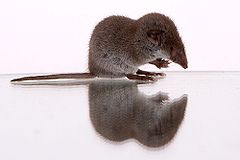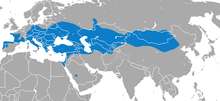- Lesser White-toothed Shrew
-
Lesser White-toothed Shrew[1] 
Conservation status Scientific classification Kingdom: Animalia Phylum: Chordata Class: Mammalia Order: Soricomorpha Family: Soricidae Genus: Crocidura Species: C. suaveolens Binomial name Crocidura suaveolens
(Pallas, 1811)
Lesser White-toothed Shrew range The Lesser White-toothed Shrew (Crocidura suaveolens) is a tiny shrew found in Europe, but not on the mainland of Great Britain.[3] Its preferred habitat is scrub and gardens and it feeds on insects, worms, slugs, snails and small mice. The closely related Asian Lesser White-toothed Shrew (Crocidura shantungensis) was once included in this species, but is now considered to be a separate species.
Like the common shrew, a female lesser white-toothed shrew and her young may form a "caravan" when foraging for food or seeking a place of safety: each shrew grips the tail of the shrew in front so that the group stays together.[3]
The Scilly Shrew
The population found on the Isles of Scilly, off the south-west coast of England, is thought to be a sub-species, Crocidura suaveolens cassiteridum, which is unqiue to those islands[3] and is known as the Scilly Shrew. It is unusual in that it is found on the islands' beaches. Archaeological remains indicate that it was present on the islands in the bronze age, so it may have been present before the Isles of Scilly became separated from the European continent, or may have migrated from the Channel Islands or Europe on-board ships.[4]
In July 1924 W N Blair found an unknown species of Shrew on Gugh and sent it to the mammal expert, Mr Hinton, at the British Museum. This specimen, held at the museum, is the type for the species.[5] Ten years earlier H N Robinson found an unknown rodent at Old Town St Mary's and sent it to Mr F W Smalley "who had the largest collection of rodents in the country". The Scillonian name for the animal is "teak" or "teke".[6] In 2010, a Scilly shrew made headlines on BBC Cornwall when it stowed away on the passenger ferry RMV Scillonian III. It was only discovered as the ship was about to arrive in Penzance. The shrew was flown back to the Isles of Scilly the next day on a Skybus plane and then released back into its natural environment.[7]
References
- ^ Hutterer, Rainer (16 November 2005). Wilson, Don E., and Reeder, DeeAnn M.. ed. Mammal Species of the World (3rd ed.). Baltimore: Johns Hopkins University Press, 2 vols. (2142 pp.). pp. 250. ISBN 978-0-8018-8221-0. OCLC 62265494. http://www.bucknell.edu/msw3.
- ^ Insectivore Specialist Group (1996). Crocidura suaveolens. 2006. IUCN Red List of Threatened Species. IUCN 2006. www.iucnredlist.org. Retrieved on 2006-05-12. Database entry includes a brief justification of why this species is of least concern
- ^ a b c "Lesser white-toothed shrew". ARKive. http://www.arkive.org/lesser-white-toothed-shrew/crocidura-suaveolens/#text=All. Retrieved 21 December 2010.
- ^ "Scilly shrew". Isles of Scilly Wildlife Trust. http://www.ios-wildlifetrust.org.uk/wildlife/scilly_mammals/scilly_shrew.htm. Retrieved 21 December 2010.
- ^ Blair, W.N. (1926) Blair's White-toothed Shrew. Scillonian 5:164-5.
- ^ Robinson, H.W. (1925) A New British Animal Discovered in Scilly. Scillonian 4: 123-4
- ^ Cornish ferry stowaway shrew flown home, 17 June 2010 (accessed 2011-08-16)

